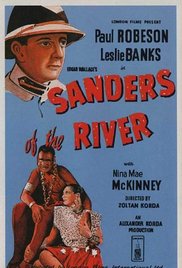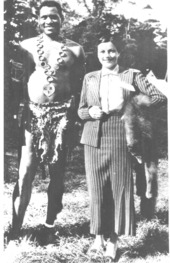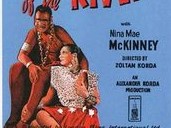Sanders of the River *** (1935, Paul Robeson, Leslie Banks, Nina Mae McKinney) – Classic Movie Review 5823
Leslie Banks stars as Edgar Wallace’s British colonial District Commissioner in Nigeria R G Sanders, who captures bad guys Lieutenant Tibbets (Robert Cochran) and J Ferguson (Martin Walker, who have sold guns and gin to the natives. Sanders also rescues kidnapped Bosambo (Paul Robeson, looking awkward in jewellery and a loincloth), the African chief who backs the British.
Lajos Biró, Jeffrey Dell and Arthur Wimperis adapt Edgar Wallace’s 1911 colonial adventure novel Sanders of the River. Mischa Spoliansky won the award for Best Music at the Venice Film Festival 1935. The film was a box-office and critical hit.
African-American actor-singer Robeson, who may later have regretted his participation when his literate and educated Nigerian chief character was turned into a servile lackey of British colonial rule, nevertheless has the best of what is going in the movie, and sings composer Mischa Spoliansky’s fine arrangements of African songs. Another African-American actor, Nina Mae McKinney, also stars as Bosambo’s wife Lilongo.
Director Zoltan Korda’s handsomely produced 1935 GB film with Georges Périnal’s distinguished, gleaming outdoors black and white cinematography and Vincent Korda’s handsome production designs remains interesting culturally and historically as a shining relic from the now largely discredited days of Empire, and Robeson shows that he is an extremely charismatic player.
Director Zoltan Korda is producer Alexander Korda’s brother. They sent a film crew on a four-month trip into remote areas of Africa to record traditional African dances and ceremonies, to integrate the footage with scenes shot in the London studio at Denham Studios, Buckinghamshire. This well-meaning attempt seems to have been undermined in the last days of shooting and the editing stage, changing the film’s drift and intentions. Incidentally, it is edited by future Ealing Studios director Charles Crichton. British colonial administrator Sir B Bourdillon is credited as an adviser on the film.
Jomo Kenyatta, Kenya’s later President and Prime Minister, has a bit part as one of the extras filmed in Africa. Also in the cast are Richard Grey as Captain Hamilton, Toto Ware as King Mofolaba, Marqués De Portago as Farini, Eric Maturin as Smith, Allan Jeayes as Father O’Leary, and Charles Carson as Sir John
Civil rights activist Robeson said in 1938: ‘It is the only film of mine that can be shown in Italy or Germany, for it shows the negro as Fascist states desire him – savage and childish. It is ironic then that it give Zoltan Korda the first of his four nominations for Best Foreign Film at the Venice Film Festival – the Mussolini Cup.
When Robeson did retakes in the studio, he found the film’s message had been changed in the editing. To him it seemed to justify imperialism and upholding the White Man’s Burden and found that, instead of showing the roots of Black culture and portraying Africans positively, it was dedicated to ‘the handful of white men whose everyday work is an unsung saga of courage and efficiency’.
Trying unsuccessfully to buy back and bury all prints of the film, Robeson concluded: ‘I hate the picture. The imperialist plot had been placed in the plot during the last days five days of shooting. I wanted to portray the culture of the African people and I committed a faux pas which convinced me that I had failed to weigh the problems of 150 million native Africans.’
It is parodied in Will Hay’s 1938 comedy Old Bones of the River, rather tastelessly given the circumstances, and reworked as Death Drums along the River (1963) and its sequel, Coast of Skeletons (1965).
© Derek Winnert 2017 Classic Movie Review 5823
Check out more reviews on http://derekwinnert.com




